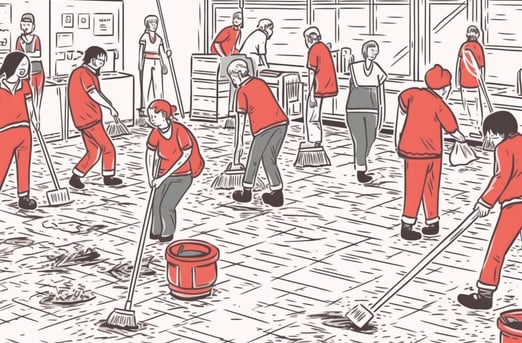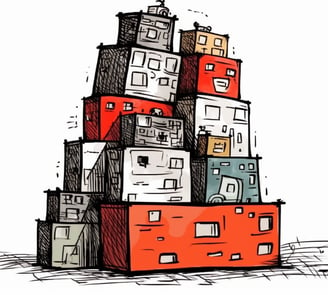Improve with Good Housekeeping - Lean 5S Method
PROCESS
There are several methodologies that exist and they all have been developed for different reasons and to solve different problems. Sometimes there are sub-methodologies that fall under larger methodologies. The 5S methodology is a system that falls under Lean practices. Lean, the original ‘elimination of waste’ system developed by Toyota.
The 5S method is a standardization system that when property implemented can help to create and maintain an organized, safe, clean and efficient workplace. There are several visual controls as part of the implementation of 5S to help enforce non-conformance and makes non-conformance easily detectable.
In all honesty, 5S principles are not rocket science and probably something that your grandmother could have shown you because they are basic housekeeping practices, structured with a catchy name.
Nonetheless, the tools are extremely effective in helping to eliminate waste. The 5S’s come from Japanese words that I am not even attempting to know how to pronounce.
The 5S methodology was originally developed for a physical environment, however the same principles can be applied to a services/business environment as well. I provide some examples of each for a non-physical enviornment.


#1 - Sort
This is about going through the workspace, reviewing the items and evaluate every single item. Ask the question, is this absolutely essential for getting the job done. Whatever is not deemed essential should be eliminated or moved to a space away from high-access areas.
Business Example: Are the files or folders in your computer organized into into proper labeled folders. Do have a random mess of files or things that should be in the ‘trash’ on your desktop, making it hard to find anything? Do you have duplicate files or 4 versions of ‘Copy of XYZ File’ just sitting around somewhere in your computer. I know this may seem like a pointless thing to waste your time on, but I personally believe that an organized space leads to organized and clean thoughts, allowing you to think and focus. Jordan Peterson has famously quoted, “If you want to organize your psyche, you could start by cleaning up your room.”


#2 - Set in Order
This is where you apply the principle of “there is a place for everything.” Ensure items are organized by function and by frequency of use. Often there is waste when looking for things when they are not where they should be or even worse when there is no system at all.
Business Example: Something that I like personally doing is color-coding my calendar. It’s an easy feature available in Outlook that allows to create colors and you can name the category of that color. Every meeting that I accept or schedule, I immediately color code it and when I look at my calendar at any random time, I can quickly scan and determine what my day will consist of without reading anything. I also know which time is flexible, what is not, what I need to prepare for or what I can just show up to and so on.
#3 - Shine
This is how it sounds and it is about cleaning the workspace area. Dirty work materials can lead to equipment failure leading to loss of time caused by repairing or resolving. Poor cleanliness can also lead to safety issues and further inefficiencies.
Business Example: This can apply to the the way you generally look at the processes and the design of the processes in your business. This is more philosophical but also requires taking a step back and looking an an entire system you have built or it currently running. Are your vendor’s ever paid late or paid inaccurately, can the process you use to pay vendors use some clean up, is there some waste built into that process which should be eliminated or cleaned up? Most processes can use a good ‘clean up’, and for this reason a good operational professional should never be bored.
#4 - Standardize
This step is likely considered the most important of the S’s. This is about work instructions, checklists, standard work, and other documentation. Often visual cues and visual management is utilized to help reduce decision-making time and to help train positive behaviors.
Business Example: A well-run call center, which consists of call center agents placing outbound or taking inbound calls has a well-defined call flow for most types of scenarios that a call center agent will face 90% of the time. Those agents should have a standardized set of steps to take when speaking on scenario ABC, and when scenario ABC is encountered the agent should be trained to document the system of record a certain way. Why? In the future for better and ‘cleaner’ data analysis, call volumes and types can be analyzed better for improving operations. There is a saying that engineers know as it pertains to data, ‘junk in, junk out’, corresponding to if you have bad data going in you will have incorrect observations when trying to analyze that data.
#5 - Sustain
This is about ensuring there is a continuation and no loss of the work put forward to ensure sustainability of the strong practices. Often to do this, an audit system is put in place to ensure there is consistency. This is also about ensuring there is a continuous challenge of the practices put in place to never stop improving.
Business Example: Hopefully, one clear application of this principle is having a governance process in place. Governance systems, are usually in place to ensure there are checks and balances and to ensure that the systems that were put in place such as something as basic as policies and procedures or as impactful as the executive hires or fires.
Why Do it?
The benefits from a well-implemented 5S system leads to a workplace that helps to easily identify and reduce various forms of waste. An organized workspace can help to reduce excessive motion, wasted time looking for things, and when things are in place it is easy to spot things out of place.
There are several resources out there available to help explain and learn about 5S, however the gist of it is included here. The next step is putting it into practice in not only your workplace, but your home can benefit as well. Chances are you are already utilizing 5S practices, just not calling it this formal name. I challenge you to try to doing one or two of these in your organization.






